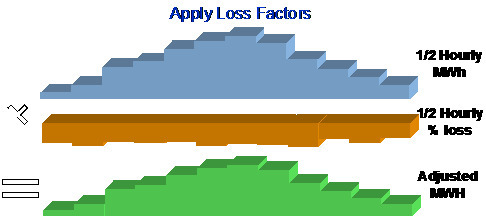The Big Picture of Data Derivation
Data derivation algorithms are used when a customer's contract requires interval data that is created based on other interval data in the system.
Some examples may include:
- Adjusting measured demand to account for loss factors to produce an adjusted billable data curve
- Comparing measured data to a contract demand curve to produce an adjusted billable data curve
- Comparing measured data to a maximum demand curve to produce an excess load curve
- Aggregating raw interval data from multiple interval registers linked to the service agreement's service points
- And more...

How is this set up in the system? Using the above loss factor example, let's make the following assumptions:
- The ½ Hourly MWh curve is an SA Owned profile linked to the service agreement. Its data is interfaced into the system from an external source. Refer to Upload Interval Data for more information.
- The ½ Hourly % loss are common for a group of customers and are stored as bill factor interval values. Refer to Bill Factor Interval Values for more information.
- The Adjusted MWh curve is an SA Owned profile linked to the service agreement. Its data is created by the system through a Creation data derivation algorithm linked to the profile type.
The creation algorithm (that would need to be written to handle this example) would be provided with the profile relationship type of the ½ Hourly MWh curve and the Bill Factor for the loss factors. It applies the percentage loss factor for each interval and stores the result for each interval as a new data set for the Adjusted MWh curve.
These algorithms may be executed in one of the following ways:
- Through a background process that finds every SA that has an interval profile whose profile type indicates a creation algorithm. Refer to Process IB-SPDB - SA Interval Profile Data Creation for more information.
- There is a button available on the SA Interval Info page that allows a user to execute the data derivation algorithms for a single SA.
- There is a button available on the Account Interval Info page that allows a user to execute the data derivation algorithms for all the service agreements for an Account. The service agreements are processed in the billing processing sequence order defined on their SA type.
